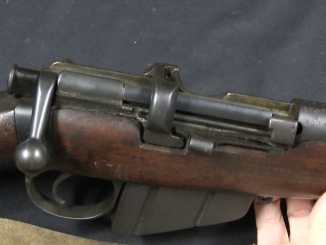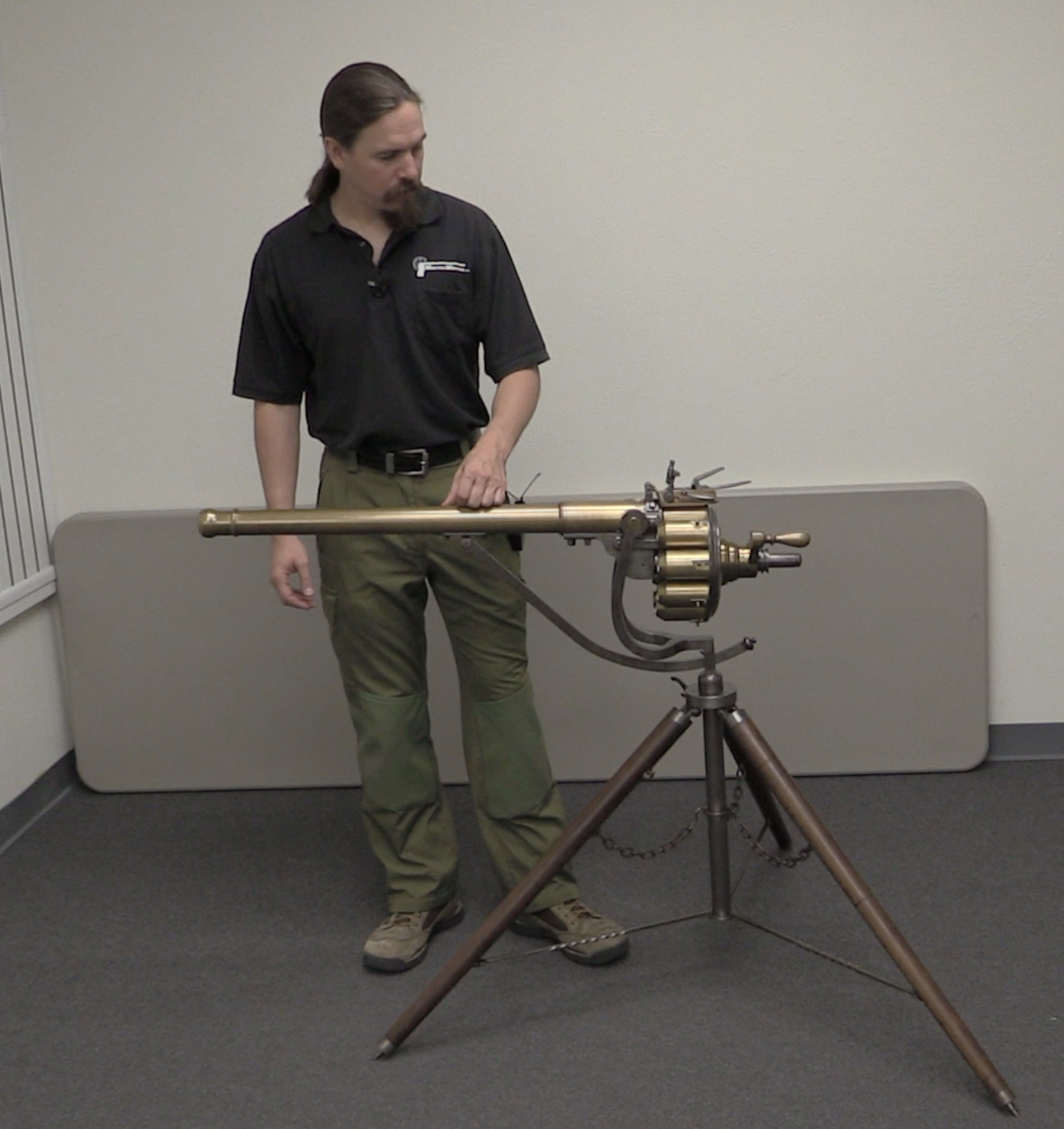This revolver is lot #2573 at Morphy’s April 2019 auction.
There were probably less than a hundred of these Pryde-Patent break-action .577 revolvers made in total, and this one has managed to maintain an excellent nickel finish. Pushing approximately a 400 grain bullet at about 725 fps, these 5-shot revolvers were made as last-ditch “stopping” guns in case of attack by large animals, and most of them were taken to India during the Victorian period. This one was made in Belgium, and then retailed by Thomas Wilson in London.




577?! That’s the caliber of the old Snider-Enfield! I suspect that nobody should really use this unless the express rifle has jammed in front of a rhino. And even then, good luck!
It would be the same caliber, but not the same round.
I know that, it’s just that I remember the old saying: “don’t fix any object or system that isn’t broken.” It is likely that someone decided to use .577 caliber in this gun as production tooling for .577 already existed. There was no need to reinvent the wheel, so to speak! As for ammunition, one can imagine a Snider bullet packed into a shorter case, so that new bullet mold patterns would not be required. I am just guessing about it…
The “.577″ refers to the basic cartridge case. Most of these used the .577 Enfield rifle case cut down to about 1.125″ case length. As such, most of them ended up using a .600 caliber bullet due to the slight taper of the Enfield case; the majority have bores that slug about .595″ to .601”.
In their own time, the cartridges were sold by Kynoch and Eley as the “.577/.600 Revolver” round, usually subtitled “Adapted to Webley, Tranter, and Pryse Revolvers”.
cheers
eon
By the way…
1.…what is the connection between .577 Tranter, .577 Boxer, .577 Eley, .577 Webley? As far as I know, .577 Boxer, .577 Eley, .577 Webley are the various name of the same cartridge.
2. ….600 Gilon (or Gillon?): it is a pretty misterious cartridge. According to a comment, it is “non-heeled version of .577 [Boxer?]”.[https://www.forgottenweapons.com/1847-walker-revolver-at-ria/] But how can a cartridge variant with non-heeled bullet have a larger diameter than a variant with heeled bullet?
AFAIK, you can add “.577 Tranter” to that “same cartridge” list. According to Kynoch and Eley, they were all the same 1.125″ long,cut-down .577 Enfield rifle case, only differing in bullet weights.
Supposedly, since all the revolvers were fixed sight types with the sights “set” (as much as they could be) at the factory, the loads were all intended to shoot center (point of aim) out to 50 yards. The idea being that that was about as far as an officer should reasonably be shooting at somebody to protect himself from, say, an obstreperous native with a throwing spear or a muzzleloading musket.
Officers were supposed to supervise, not shoot; their job was to tell the riflemen what to do. They were only to engage in “personal combat” when “personally” threatened at close range. Hence the .577/.600 revolver; the idea being that if you needed to actually shoot somebody, you needed that “somebody” to fall down dead right now.
Since at the time, muzzle velocities were limited by the burning characteristics of black powder (meaning, short-barrelled revolvers had a limit of about 600 to 700 F/S), the only way to get more foot-pounds of kinetic energy was to use a heavier bullet (mass x square of velocity). And the only way to get a heavier bullet was to increase its diameter.
Hence the .577/.600 in Europe, and .the .45 Colt and .44 WCF over here. Even today, Americans tend to equate big bores with more power.
Given sufficient velocity, medium to small bores (9mm to 7.65mm) can do all the damage required, especially with expanding bullets to ensure that the projectile stops in the target and delivers all its energy to same, rather than going on through and wasting it on the landscape behind the intended recipient. (The major fault of the .41 and .44 Magnum revolver rounds in CQB.)
But if velocity above about 65% to 70% of the speed of sound is not doable, you’re going to need a big, heavy bullet. Which was what the .577/.600 and the American .45 and 44 delivered.
cheers
eon
Thank you for your detailed answer. 🙂
According to https://naboje.org/node/12981# various bullets were used in .577 Revolver ranging from 19,70 g to 31,7 g. One weighting 29,7 g is said to have muzzle velocity 220 m/s.
I’m not sure you could call this “Small arms”, really nice and would be a really nice addition!
Hellboy’s Samaritan!(his is a little bigger :))
Watsons is still a privately-owned gunmaker, though they’re no longer on Pall Mall.
These days their guns start at around £75,000.
https://www.watsonbrosgunmakers.com/new-guns/
Nice guns!
I know what you’re thinking: “Did he fire six shots or only five?” Well, to tell you the truth, in all this excitement, I’ve kinda lost track myself. But being this is a .577 Caliber Bland-Pryse Stopping Revolver, the most powerful handgun in the world, and would blow your head clean off, you’ve got to ask yourself one question: ‘Do I feel lucky?’ Well, do ya, punk?
If you’re staring down the barrel and asking if he has any bullets left, you’ve done something stupid, namely getting too close to dodge bullets but not close enough to beat the gun aside. So no, I don’t feel particularly lucky.
You’re also dumb enough not to look at the front of the cylinder to count the empty (or loaded)chambers. The one you have to worry about if the gun isn’t cocked, is the one to one side or the other of the barrel, depending on which way the cylinder rotates.
One of the nice things about automatics is that unless he keeps count, your opponent doesn’t know how many rounds you have available. His only sure sign that you’re “Winchester” is if the slide is locked back on an empty chamber.
For this reason, I was taught (and when teaching, I taught my students) to reload while there was still one round “up the spout”. Just in case.
cheers
eon
“(…)the most powerful handgun in the world(…)”
Until someone build stronger one, like for example https://www.thefirearmblog.com/blog/2011/09/29/massive-homemade-12-gauge-revolver/
If somebody could build some cartridges and load them to approximate the original, I’d be happy to
watch _him_ fire it.
400 at 725 means 290000 momentum.
For comparison according to http://www.ballisticsbytheinch.com/44mag.html heaviest-bulleted tested .44 Magnum has 240 bullet. Lets assume 5″ barrel, then it is 240 at 1367 giving 328080 momentum. This mean with all other being equal felt recoil of that .577 would be around 88% of 44 Magnum – still serious, but less that first impression after looking at muzzle might suggest.
‘Rapid reload?’ I should think you could get off a following shot after the cast came off of your wrist.
But who needs a follow up? You could probably stop most anything by THROWING a 400 gr bullet at it.
The top-break Pryse was a much faster reload than the earlier Webley.
With it, you had to release the cylinder base-pin catch, remove the base pin, remove the cylinder and its backing plate (which rotated with it and had six holes for the hammer-mounted firing pin to strike the primers through), push out the empties with the base pin, reload, replace the backing plate, put it and the cylinder back in, and finally put the base pin back and relatch it.
Note that unlike Remington and Adams percussion and metallic-cartridge revolvers prior to 1870, the Webley did not come with a spare cylinder or two. So fast “autopistol” type reloads, easily accomplished with the other brands with pre-loaded cylinders, weren’t possible with the Webley.
The assumption was apparently that if six .577/.600 rounds didn’t solve the problem, you were probably dead anyway. What you were supposed to do if you dropped six Zulu warriors and then #7 showed up with an assegai in his hand, is something that never got mentioned.
PS. Note that irrespective of the movies Zulu (1964) and Zulu Dawn (1979), in 1879 at Isandlwana and Rorke’s Drift, it was revolvers like this, or the earlier Webley or Tranter .577/.600s, that the officers like Lts. Bromhead and Chard would have had, rather than the much later .455in Webley top-breaks shown in the films.
cheers
eon
Déjà vu…
“(With upper-class British accent) ‘…But, being this is a .577 Tranter, the biggest God Damn revolver in the British Empire, and would make a rather large mess of things if I shoot you, you’ve got to ask yourself a question: Do I feel lucky. Well, do you, you rebel scum?’
Major Harold ‘Dirty Harry’ Callahan, 5th Cavalry, to native rebel.” [https://www.forgottenweapons.com/577-caliber-tranter-revolver/]
Is there any way to tell “EdwardTus” to frell off without getting on his spam hit list?
clear ether
eon
I asked Mr. McCollum to nuke him earlier.
Annnddd another one pops up.
clear ether
eon
The last time Cabal had been to the gunsmith’s in town to buy more cartridges for it, the man behind the counter had told hi that the pistol, a Webley .577 Boxer, was ‘guaranteed to stop a charging savage’ according to the literature. Cabal had replied that he didn’t know about that, but it could stop a Deep One with its dander up and that was good enough for him.
— The Death Of Me: A Johannes Cabal short story
By Johnathan L. Howard
The FBI says that the 9mm has basically the same stopping power.
The FBI would say that though because they’re americans and are compensating for their tiny 9mms in the presence of a huge near 60 calibre British monster.
Alguien me podría decir el valor aproximado de un revólver 577? Y cuanto se fabricaron en total?
Wow this would stop your average moon faced 50 stone american land whale charging at you dead in their tracks and I reckon it would blow the living fuck out of a kraut and jap too.
You were the worst Bond!
Sorry, I don’t know what came over me, but that wasn’t nice about the whales.